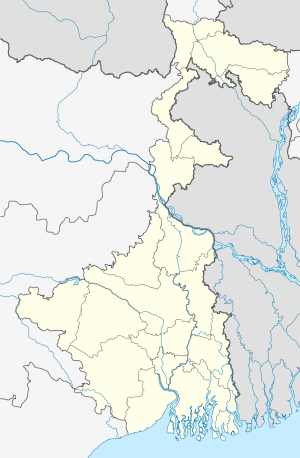Ausgram I (community development block)
| Ausgram I (CD Block) আউসগ্রাম I সমষ্টি উন্নয়ন ব্লক | |
|---|---|
| Community development block | |
 Ausgram I (CD Block) Location in West Bengal | |
| Coordinates: 23°31′04″N 87°39′37″E / 23.51778°N 87.66028°E | |
| Country |
|
| State | West Bengal |
| District | Bardhaman |
| Parliamentary constituency | Bolpur |
| Assembly constituency | Ausgram |
| Area | |
| • Total | 63.51 sq mi (164.50 km2) |
| Elevation | 130 ft (40 m) |
| Population (2001) | |
| • Total | 106,813 |
| • Density | 1,680/sq mi (649/km2) |
| Time zone | IST (UTC+5.30) |
| Literacy Rate | 62.53 per cent |
| Website | http://bardhaman.gov.in/ |
Ausgram I (community development block) is an administrative division in Bardhaman Sadar North subdivision of Bardhaman district in the Indian state of West Bengal. Ausgram police station serves this block. Headquarters of this block is at Guskara.[1][2]
Geography
Ausgram is located at 23°31′04″N 87°39′37″E / 23.5178°N 87.6602°E.
Ausgram I community development block has an area of 164.50 km2.[2]
The uneven laterite territory in the western part of Bardhaman district extends up to Ausgram and then the alluvial flood plains commence.[3] The entire Durgapur-Kanksa-Faridpur-Ausgram area was densely forested even in more recent times. The influx of refugees from East Pakistan and their rehabilitation in the area, and irrigation facilities extended by Damodar Valley Corporation led to destruction of much of the forests in the area, but some still remain.[4]
Gram panchayats
Gram panchayats of Ausgram I block/panchayat samiti are: Ausgram, Berenda, Billagram, Dignagar I, Dignagar II, Guskara II and Ukta.[5]
Villages
Villages as of 2011 were Alefnagar, Aligram, Alutia (P), Asinda, Ausgram, Ausgram Chak, Baburbandh, Bahamanpur, Ban Nabagram, Bara, Bara Chatra, Batagram, Belari, Belgram, Beluti, Beranda, Bhada, Bhatgonna, Bhota, Brajapur, Chonari, Deasa, Digha, Dignagar, Dwariapur (P), Gangarampur,Gopinathbati, Gobindapur Purbba, Gonna, Jadabganj, Jaykrishnapur, Kalyanpur, Karanji, Karatia, Kayrapur, Kumarganj, Kunjanagar, Kurumba, Lakshmiganj, Majhergram, Mallikpur, Nabagram, Naoda, Nripatigram, Parasurampur, Pichkuri, Purbba Tati, Ramchandrapur, Sahapur, Shibada, Shibbati, Shitalgram, Silut, Soara, Somaipur, Srikrishnapur, Srinagar, Sundalpur, Takipur, Telota, Ukta and Warishpur.[6]
History
Medieval history
The area between the Damodar and Ajay was known as Gopbhum, where the Sadgope kings ruled for many centuries, prior to the advent of the Muslims. The Sur kings also occupy a somewhat mythical position in the region. Adi Sur of this dynasty is credited with having brought the five Brahmins and Kayasthas (two important upper castes in Bengal) from Kannauj in what is now Uttar Pradesh.[7]
In the 18th century the area faced massive attacks of the Bargi warriors.[8]
Administrative set ups
In 1846, when Bud Bud subdivision was created, Ausgram was one of the three thanas or police stations, the other two being Bud Bud and Sonamukhi. In Peterson’s District Gazeteer of 1910, Ausgram is mentioned as one of the police stations of Bardhaman subdivision.[9]
Movements
This being a canal-irrigated area it had faced agitations against the imposition of taxes for canal water.[10]
Demographics
As per 2001 census, Ausgram I block had a total population of 106,813, out of which 54,623 were males and 52,190 were females. Ausgram I block registered a population growth of 13.75 per cent during the 1991-2001 decade. Decadal growth for Bardhaman district was 14.36 per cent.[2] Decadal growth in West Bengal was 17.84 per cent.[11]
Scheduled castes at 39,576 formed around one-third the population. Scheduled tribes numbered 14,191.[12]
Literacy
As per 2001 census, Ausgram I block had a total literacy of 62.53 per cent for the 6+ age group. While male literacy was 71.85 per cent female literacy was 52.77 per cent. Bardhaman district had a total literacy of 70.18 per cent, male literacy being 78.63 per cent and female literacy being 60.95 per cent.[13]
Health
Ausgram I CD Block is one of the areas of Bardhaman district which is affected by arsenic contamination of ground water.[14]
Art
The area is renowned for its dhokra art castings.[15] In particular, Dariapur village in the area is famous for its dhokra metal craft.
External links
References
- ↑ "Contact details of Block Development Officers". Burdwan district. West Bengal Government. Retrieved 2011-09-07.
- 1 2 3 "Provisional population totals, West Bengal, Table 4, Barddhaman District". Census of India 2001. Census Commission of India. Retrieved 2011-09-07.
- ↑ Chattopadhyay, Akkori, Bardhaman Jelar Itihas O Lok Sanskriti (History and Folk lore of Bardhaman District.), (Bengali), Vol I, p18,28, Radical Impression. ISBN 81-85459-36-3
- ↑ Chattopadhyay, Akkori, p38, 542
- ↑ "No. 229 (Sanction)-PN/P/II/1G-5/2005(Pt.II) dated 02.02.09". Allotment No. 5 for five districts – Cooch Behar, Burdwan, Uttar Dinajpur, Hooghly and Bankura. Government of West Bengal - Department of Panchayats & Rural Development. Retrieved 2011-08-26.
- ↑ "Villages in Ausgram - I C.D.Block". vlist.in. Retrieved 2011-11-10.
- ↑ Chattopadhyay, Akkori, pp 150-151
- ↑ Chattopadhyay, Akkori, pp209, 292-293
- ↑ Chattopadhyay, Akkori, p369
- ↑ Chattopadhyay, Akkori, p472
- ↑ "Provisional Population Totals, West Bengal. Table 4". Census of India 2001. Census Commission of India. Archived from the original on 21 July 2011. Retrieved 2011-08-26.
- ↑ "TRU for all Districts (SC & ST and Total)". Census 2001. Census Commission of India. Retrieved 2008-08-26.
- ↑ "Provisional population totals, West Bengal, Table 5, Bardhaman District". Census of India 2001. Census Commission of India. Retrieved 2011-08-26.
- ↑ Arsenic contamination
- ↑ Dokra Art